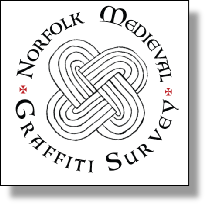









These often small inscriptions have been the subject of antiquarian interest for many years, although with little agreement as to their meaning and function. Their similarity to a number of medieval board games, most notably Merels and Nine-Mans-Morris, have led to them often being thought of as smaller versions of the same games. Indeed, a number of early writers on the subject described the simplest rectangles with crossed lines as ‘three-mans-morris’, or even the unlikely ‘one-mans-morris’.
The problem with such an interpretation is fairly straightforward, in that gaming boards, such as that shown at bottom right, ARE found in our churches and cathedrals. However, these are invariably located on horizontal surfaces such as benches and window reveals, whilst most of the other motifs are being recorded on vertical surfaces. The motif also turns up in a number of manuscript illustrations, where it is associated with astrology and the making of horoscopes, and it shares many features with other recognised symbols of protection. It is also notable that at sites such as Swannington, Lidgate and Ashwell, the same symbol is to be found in concentrations of other ritual protection marks, clearly suggesting that it was regarded as performing a similar function. However, as with many symbols found amongst the graffiti, the meaning and function of any motif may change and be entirely dependent upon the circumstances in which it was created.















